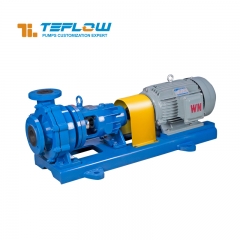In chemical production processes, centrifugal pumps are core equipment for fluid transportation, and their stable operation is directly related to production efficiency and safety. However, chemical media are often corrosive, volatile, or contain gases. Traditional centrifugal pumps are prone to problems such as gas binding and cavitation during startup and operation, resulting in pump vibration, flow rate reduction, and even component damage. Siphon buckets, as key auxiliary devices for chemical centrifugal pumps, provide an efficient solution to these pain points through ingenious fluid dynamics design.
一、Working principle of siphon bucket: fluid-assisted mechanism based on the "siphon effect"
To understand the function of the siphon bucket, we must first clarify its core principle: "the combination of siphon effect and negative pressure drainage." In chemical centrifugal pump systems, the siphon bucket is usually installed between the pump inlet and the liquid storage tank. Its working process can be divided into three stages:
1.Pre-filling stage: Before the first start, a liquid compatible with the conveying medium (usually the medium to be conveyed) must be injected into the siphon barrel to expel the air in the barrel to form a liquid seal inside the barrel;
2.Negative pressure formation stage: When the centrifugal pump is started, the pump impeller rotates at high speed to generate negative pressure, which generates suction on the liquid in the siphon bucket through the inlet pipe. At this time, the pressure in the bucket is lower than the liquid level pressure in the storage tank;
3.Siphon circulation stage: Under the action of pressure difference, the medium in the liquid storage tank continuously flows into the siphon barrel through the liquid inlet pipe, and then enters the pump body through the siphon barrel outlet, forming a stable fluid cycle of "liquid storage tank → siphon barrel → centrifugal pump". Even if there is a brief interruption in the pump body's inlet, the liquid stored in the siphon bucket can be temporarily replenished, preventing a vacuum in the pump.
The key to this design is to utilize the "buffering and pressure stabilization" function of the siphon bucket to convert the instantaneous negative pressure at the centrifugal pump inlet into a continuous and stable liquid flow supply, thereby fundamentally solving the problem of unstable liquid supply caused by gas content in the medium and liquid level fluctuations.
二、The core function of the siphon bucket: solving the pain points of chemical centrifugal pump operation
In chemical production scenarios, the auxiliary role of siphon buckets for centrifugal pumps is mainly reflected in the following four aspects, directly covering the full cycle requirements of "start-up - operation - maintenance":
1.Eliminate air binding and ensure smooth pump startup
Air binding is a common problem during centrifugal pump startup. If air is trapped within the pump or inlet piping, the negative pressure generated by the rotating impeller prevents the pump from drawing in liquid, causing the pump to run dry and fail to deliver the fluid. The traditional solution requires manual filling of liquid into the pump to exhaust the air, which is not only cumbersome to operate but also easily poses a safety risk to personnel due to the corrosive nature of the medium.
The siphon barrel is designed with a liquid seal pre-filling function, which can discharge the air in the inlet pipe in advance, and the liquid stored in the barrel can quickly fill the impeller chamber when the pump is started. Even if the liquid level in the storage tank is lower than the pump inlet (i.e., negative pressure suction scenario), the siphon bucket can draw the liquid into the pump through the pressure difference, completely avoiding air binding failures and achieving one-button start of the centrifugal pump. It is especially suitable for high-position pumps in large chemical plants that are difficult to operate manually.
2.Inhibit cavitation and extend the service life of the pump
Chemical media often contain dissolved gases (such as oxygen and carbon dioxide), or the medium may vaporize due to temperature changes or sudden pressure drops, forming bubbles. When these bubbles enter the high-pressure area of the centrifugal pump impeller with the liquid flow, they will quickly burst to produce microjets, which will impact the impeller surface and cause cavitation. This is manifested as honeycomb damage on the impeller surface, increased vibration and noise of the pump body, and decreased flow head. In severe cases, the entire impeller needs to be replaced, increasing maintenance costs.
The siphon bucket's stabilizing flow and pressure-reducing effects can effectively inhibit cavitation: on the one hand, the larger volume inside the bucket can slow down the liquid flow rate, allowing bubbles in the medium to escape early and be discharged through the exhaust valve; on the other hand, the siphon bucket avoids a sudden drop in pressure at the pump inlet by optimizing the pipeline resistance design, reducing the possibility of medium vaporization. Practical data from a chemical company shows that the cavitation failure rate of centrifugal pumps equipped with siphon buckets has decreased by over 70%, and the impeller service life has been extended by 2-3 times.
3.Stabilize flow and lift, improve production accuracy
Chemical production has extremely high requirements for the stability of fluid transportation. The flow rate and head of traditional centrifugal pumps are easily affected by factors such as fluctuations in the liquid level of the storage tank and changes in the viscosity of the medium. When the liquid level of the storage tank drops, the pump inlet pressure decreases and the flow rate decreases accordingly; when the viscosity of the medium increases, the pipeline resistance increases and the head will be significantly attenuated.
The siphon barrel can balance the fluctuation of inlet pressure through its buffering and adjustment function: the liquid stored in the barrel is equivalent to a temporary liquid storage tank. When the liquid level in the storage tank drops, the liquid in the siphon barrel can be temporarily replenished to maintain the stable inlet pressure of the pump; at the same time, the flow stabilization structure in the barrel can reduce the impact of changes in medium viscosity on the flow rate, ensuring that the flow rate and head output by the centrifugal pump always remain within the process requirements.
4.Simplify system design and reduce installation and maintenance costs
In the layout of chemical plants, if the liquid storage tank is located low (such as an underground storage tank), traditional centrifugal pumps need to be additionally equipped with a vacuum pump or ejector to achieve negative pressure liquid suction, which not only increases equipment investment but also requires complex pipeline connections and control systems.
The siphon bucket has a relatively simple structure (primarily consisting of a barrel, liquid inlet pipe, liquid outlet pipe, and exhaust valve). It can be directly connected to the centrifugal pump inlet pipe without the need for additional power equipment. Furthermore, siphon buckets require minimal maintenance, requiring only regular checks of the exhaust valve seal and the liquid level in the bucket, without the need for frequent disassembly and repair. Compared to vacuum pump systems, annual maintenance costs can be reduced by over 50%. Furthermore, for corrosive media, siphon buckets can be constructed of corrosion-resistant materials such as stainless steel and PTFE (polytetrafluoroethylene), matching the centrifugal pump material and avoiding pipeline leaks caused by material incompatibility.
三、Applicable scenarios and selection points of siphon buckets
1.Core application scenarios
Siphon buckets are not required for all chemical centrifugal pumps. The following scenarios are particularly valuable:
Negative pressure liquid suction scenario: The liquid level in the liquid storage tank is lower than the centrifugal pump inlet, and liquid needs to be sucked upward (such as supplying liquid from an underground solvent storage tank to a reactor);
Transport of easily vaporized media: transporting media with low boiling points (such as methanol, ethanol) or high-temperature media (such as hot kerosene), which are easily vaporized due to pressure changes;
Gas-containing medium transportation: The medium contains a lot of dissolved gas (such as fermentation liquid, solution containing carbon dioxide), or the medium is a gas-liquid mixture (such as reaction tail gas condensate);
Large or high-position pump bodies: pump bodies that are difficult to fill manually and have a high starting frequency (such as circulating water pumps and raw material delivery pumps in chemical plants).
2.Key selection parameters
When selecting a siphon bucket, you need to consider the centrifugal pump and the medium characteristics, and focus on the following parameters:
Volume: It needs to be determined according to the rated flow of the centrifugal pump, usually the maximum delivery volume of the pump body in 1-2 minutes to ensure the buffering effect;
Material: Compatible with the conveying medium, 316L stainless steel and Hastelloy can be selected for corrosive media, and FEP (F46) lining can be selected for highly corrosive media;
Pressure level: Match the system working pressure to avoid deformation of the siphon bucket due to excessive pressure;
Interface size: consistent with the inlet pipe size of the centrifugal pump to reduce pipeline resistance.
In the complex environment of chemical production, the siphon bucket, while an auxiliary device, plays a key role in ensuring stable pump operation and improving production efficiency. By eliminating air binding, suppressing cavitation, stabilizing flow, and simplifying the system, it addresses many of the pain points of traditional centrifugal pumps in chemical media transportation. This not only reduces the risk of equipment failure and maintenance costs, but also provides reliable assurance for precise control of chemical processes.
As the chemical industry transforms towards "intelligence, efficiency and safety", the design of siphon barrels is also constantly upgrading: for example, integrated liquid level sensors can achieve automatic liquid replenishment, and intelligent exhaust valves are used to reduce manual intervention. In the future, siphon barrels combined with digital monitoring technology will further form a "cooperative control system" with centrifugal pumps, providing smarter and more reliable solutions for chemical fluid transportation. For chemical companies, the appropriate selection of siphon buckets is not only an option for equipment optimization but also a crucial measure for enhancing production stability and competitiveness.





 +86 18130251359
+86 18130251359 teflowpumps@tlpumps.com
teflowpumps@tlpumps.com













 +86+0563-5093318
+86+0563-5093318
